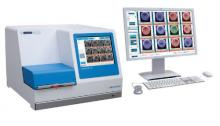
Traditionally, fertilised embryos are removed from an incubator once or twice a day and examined under a microscope to observe developmental progress. Embryos are known to have specific requirements with regards to temperature and pH which incubators provide during their time in culture, before they are transferred back into the woman. Using the built-in time-lapse photographic capabilities of the Embryoscope, scientists can now review the development of embryos at any point in time, without removing them from their incubator. Reduced handling and manipulation of the embryos may contribute to improved embryo viability.
Insights into embryo development
With the information obtained from the additional images taken by the time-lapse camera in the Embryoscope, scientists can identify optimal patterns of development or abnormalities in an embryo’s growth that may have previously gone undetected.
Identify the best embryo to transfer
Using the Embryoscope, we can track with greater precision the sequence and time at which cell division is taking place, both of which appear to have a bearing on the chance of achieving a successful pregnancy. We can obtain very accurate data on various developmental parameters, such as time to first cell division, and observe abnormal development like the direct division from one cell to three cells. This enables us to identify factors which may influence a decision to select or not select a particular embryo for transfer.
In the future, it may be that all embryos are cultured this way, however at the moment, patients who may benefit the most are:
- Women who have experienced repeated failure to become pregnant after embryo transfer
- Women whose embryos have previously failed to develop
- Women who have experienced repeated miscarriage
- Women over 35 years of age
How does Ivy, Artificial Intelligence help increase success?
The accuracy of predicting which embryo will result in a viable pregnancy can be greatly increased using Ivy. Ivy can predict the potential of an embryo to develop as far as the stage of having a fetal heart, which is a good indicator of the likelihood of a successful pregnancy.
What is different from the current IVF process?
Currently, an embryologist will manually assess each embryo based on the physical appearance on the day of transfer according to standard grading systems. The development of new incubators with time-lapse imaging (Embryoscope) has opened up new possibilities for assessing embryos. Ivy artificial intelligence performs a comprehensive three dimensional assessment of the growth of the embryos through all stages of development and then relates this data to whether a fetal heart has developed or not. By objective analysis of the images, with no pre-determined parameters, Ivy has taught itself to identify the embryos with the greatest likelihood of developing as far as a fetal heart by allocating each embryo an embryoscore. The embryo with the highest embryoscore, and therefore the highest potential for leading to a viable fetus, can then be selected for transfer, with the aim of accelerating the chance of a healthy baby.
How did the Ivy Artificial Intelligence System teach itself?
Ivy is a self-improving artificial intelligence that continuously learns from the embryos that it analyses. The artificial intelligence iteratively retrains on powerful supercomputers and has been shown to consistently improve on previous versions of itself in identifying the embryo with the highest potential for a successful pregnancy.
As an artificial intelligence system, Ivy was able to review a massive amount of data, far more than any human could ever process. Hundreds of images from each embryo were reviewed across a large series of embryos. Patterns were identified in the pictures which were then related back to whether each embryo developed into an ongoing pregnancy. Ivy was then tested by repeating the comparison against the outcomes of a separate group of embryos. The results showed a predictive value for which embryo is going to implant that is a significant improvement on any system that has been used in human embryology before.
What are the potential benefits for patients? Study is ongoing but early studies suggest the ability to improve embryo selection will increase pregnancy rates
